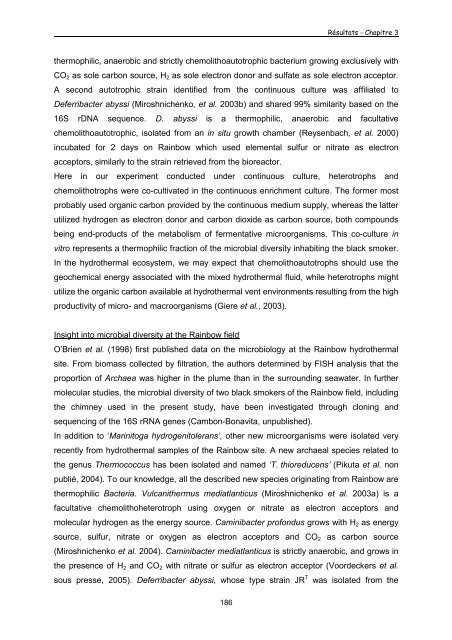THESE Anne POSTEC Diversité de populations microbiennes ...
THESE Anne POSTEC Diversité de populations microbiennes ...
THESE Anne POSTEC Diversité de populations microbiennes ...
Create successful ePaper yourself
Turn your PDF publications into a flip-book with our unique Google optimized e-Paper software.
Résultats - Chapitre 3<br />
thermophilic, anaerobic and strictly chemolithoautotrophic bacterium growing exclusively with<br />
CO 2 as sole carbon source, H 2 as sole electron donor and sulfate as sole electron acceptor.<br />
A second autotrophic strain i<strong>de</strong>ntified from the continuous culture was affiliated to<br />
Deferribacter abyssi (Miroshnichenko, et al. 2003b) and shared 99% similarity based on the<br />
16S rDNA sequence. D. abyssi is a thermophilic, anaerobic and facultative<br />
chemolithoautotrophic, isolated from an in situ growth chamber (Reysenbach, et al. 2000)<br />
incubated for 2 days on Rainbow which used elemental sulfur or nitrate as electron<br />
acceptors, similarly to the strain retrieved from the bioreactor.<br />
Here in our experiment conducted un<strong>de</strong>r continuous culture, heterotrophs and<br />
chemolithotrophs were co-cultivated in the continuous enrichment culture. The former most<br />
probably used organic carbon provi<strong>de</strong>d by the continuous medium supply, whereas the latter<br />
utilized hydrogen as electron donor and carbon dioxi<strong>de</strong> as carbon source, both compounds<br />
being end-products of the metabolism of fermentative microorganisms. This co-culture in<br />
vitro represents a thermophilic fraction of the microbial diversity inhabiting the black smoker.<br />
In the hydrothermal ecosystem, we may expect that chemolithoautotrophs should use the<br />
geochemical energy associated with the mixed hydrothermal fluid, while heterotrophs might<br />
utilize the organic carbon available at hydrothermal vent environments resulting from the high<br />
productivity of micro- and macroorganisms (Giere et al., 2003).<br />
Insight into microbial diversity at the Rainbow field<br />
O’Brien et al. (1998) first published data on the microbiology at the Rainbow hydrothermal<br />
site. From biomass collected by filtration, the authors <strong>de</strong>termined by FISH analysis that the<br />
proportion of Archaea was higher in the plume than in the surrounding seawater. In further<br />
molecular studies, the microbial diversity of two black smokers of the Rainbow field, including<br />
the chimney used in the present study, have been investigated through cloning and<br />
sequencing of the 16S rRNA genes (Cambon-Bonavita, unpublished).<br />
In addition to ‘Marinitoga hydrogenitolerans’, other new microorganisms were isolated very<br />
recently from hydrothermal samples of the Rainbow site. A new archaeal species related to<br />
the genus Thermococcus has been isolated and named ‘T. thioreducens’ (Pikuta et al. non<br />
publié, 2004). To our knowledge, all the <strong>de</strong>scribed new species originating from Rainbow are<br />
thermophilic Bacteria. Vulcanithermus mediatlanticus (Miroshnichenko et al. 2003a) is a<br />
facultative chemolithoheterotroph using oxygen or nitrate as electron acceptors and<br />
molecular hydrogen as the energy source. Caminibacter profondus grows with H 2 as energy<br />
source, sulfur, nitrate or oxygen as electron acceptors and CO 2 as carbon source<br />
(Miroshnichenko et al. 2004). Caminibacter mediatlanticus is strictly anaerobic, and grows in<br />
the presence of H 2 and CO 2 with nitrate or sulfur as electron acceptor (Voor<strong>de</strong>ckers et al.<br />
sous presse, 2005). Deferribacter abyssi, whose type strain JR T was isolated from the<br />
186
















